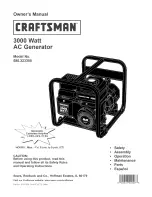
6 | Westinghouse Outdoor Power Equipment, LLC
SAFETY
wire or be double-insulated.
• When this generator is used to supply a building wiring
system the generator must be installed by a qualified
electrician and connected to a transfer switch as a
separately derived system in accordance with NFPA 70,
National Electrical Code.
• If you begin to feel sick, dizzy, or weak while using
the generator, move to fresh air IMMEDIATELY. See a
doctor, as you can have carbon monoxide poisoning.
• Only use OUTSIDE and far away from windows, doors,
and vents as recommended by the US Department
of Health and Human Services Centers for Disease
Control and Prevention. Your specific home and/or wind
conditions may require additional distance.
•
While operating and storing, keep at least five feet
of clearance on all sides of the generator, including
overhead. Allow the generator to cool a minimum of 30
minutes before storage. Heat created by the muffler and
exhaust gases could be hot enough to cause serious
burns and/or ignite combustible objects.
•
DO NOT
touch the muffler or engine. They are very
HOT and will cause severe burns.
DO NOT
put body
parts or any flammable or combustible materials in the
direct path of the exhaust.
•
ALWAYS
remove any tools or other service equipment
used during maintenance away from the generator
before operating.
• Avoid skin contact with engine oil or gasoline. Wear
protective clothing and equipment. Wash all exposed
skin with soap and water.
• A transfer switch must be installed by a licensed
electrician approved by the authority having jurisdiction.
The installation must comply with all applicable laws
and electrical codes.
FUEL SAFETY
• Store fuel in a container approved for gasoline.
•
DO NOT
smoke when filling the generator with gasoline.
•
DO NOT
allow the generator’s gas tank to overflow
when filling.
• Shut down the engine and allow it to cool for two
minutes before adding gasoline or oil to the generator.
•
NEVER
remove the fuel cap when the generator is
running. Shut off the engine and allow the unit to cool
at least two minutes. Remove the fuel cap slowly to
release pressure, keep fuel from escaping around the
cap, and to avoid the heat from the muffler igniting fuel
vapors. Tighten the fuel cap securely after refueling.
• Wipe spilled fuel from the unit.
•
NEVER
attempt to burn off spilled fuel.
•
NEVER
overfill the fuel tank. Leave room for fuel to
expand. Overfilling the fuel tank can result in a sudden
overflow of gasoline and result in spilled gasoline
coming in contact with HOT surfaces.
• Spilled fuel can ignite. If fuel is spilled on the generator,
wipe up any spills immediately. Dispose of rag properly.
Allow area of spilled fuel to dry before operating the
generator.
• Wear eye protection while refueling.
•
NEVER
use gasoline as a cleaning agent.
• Store any containers containing gasoline or in a well-
ventilated area, away from any combustibles or source
of ignition.
GASOLINE AND GASOLINE VAPOR (GAS)
Fire and explosion hazard. Gasoline and is highly
explosive and flammable and can cause severe burns
or death.
•
In case of a gas fire,
DO NOT
attempt to extinguish
the flame if the fuel tank valve is in the ON position.
Introducing an extinguisher to a generator with an open
fuel valve could create an explosion hazard.
• Gas has a distinctive odor, this will help detect potential
leaks quickly.
•
Gas vapors can cause a fire if ignited.
• Gasoline is a skin irritant and needs to be cleaned up
immediately if it comes in contact with the skin.
•
Flammable gas under pressure can cause a fire or
explosion if ignited.
WHEN STARTING THE GENERATOR:
•
Make sure that the fuel cap, air filter, spark plug, fuel
lines, and exhaust system are properly in place.
• If you spill any gasoline on the tank, allow it to fully
evaporate before operating.
•
Make sure the generator is on a flat surface before
operating.
WHEN TRANSPORTING OR SERVICING THE
GENERATOR:
• Disconnect the spark boot to prevent accidental starting.
WHEN STORING THE GENERATOR:
•
Store away from sparks, open flames, pilot lights, heat,
and other sources of ignition.







































